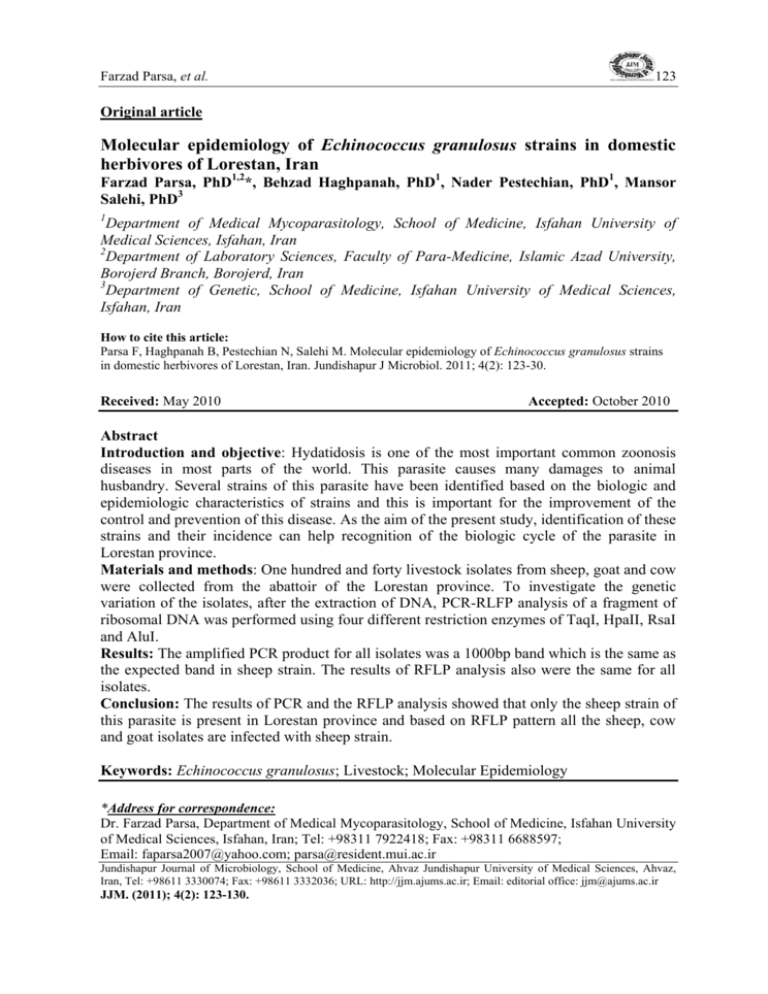Full Text
advertisement

Farzad Parsa, et al. 123 Original article Molecular epidemiology of Echinococcus granulosus strains in domestic herbivores of Lorestan, Iran Farzad Parsa, PhD1,2*, Behzad Haghpanah, PhD1, Nader Pestechian, PhD1, Mansor Salehi, PhD3 1 Department of Medical Mycoparasitology, School of Medicine, Isfahan University of Medical Sciences, Isfahan, Iran 2 Department of Laboratory Sciences, Faculty of Para-Medicine, Islamic Azad University, Borojerd Branch, Borojerd, Iran 3 Department of Genetic, School of Medicine, Isfahan University of Medical Sciences, Isfahan, Iran How to cite this article: Parsa F, Haghpanah B, Pestechian N, Salehi M. Molecular epidemiology of Echinococcus granulosus strains in domestic herbivores of Lorestan, Iran. Jundishapur J Microbiol. 2011; 4(2): 123-30. Received: May 2010 Accepted: October 2010 Abstract Introduction and objective: Hydatidosis is one of the most important common zoonosis diseases in most parts of the world. This parasite causes many damages to animal husbandry. Several strains of this parasite have been identified based on the biologic and epidemiologic characteristics of strains and this is important for the improvement of the control and prevention of this disease. As the aim of the present study, identification of these strains and their incidence can help recognition of the biologic cycle of the parasite in Lorestan province. Materials and methods: One hundred and forty livestock isolates from sheep, goat and cow were collected from the abattoir of the Lorestan province. To investigate the genetic variation of the isolates, after the extraction of DNA, PCR-RLFP analysis of a fragment of ribosomal DNA was performed using four different restriction enzymes of TaqI, HpaII, RsaI and AluI. Results: The amplified PCR product for all isolates was a 1000bp band which is the same as the expected band in sheep strain. The results of RFLP analysis also were the same for all isolates. Conclusion: The results of PCR and the RFLP analysis showed that only the sheep strain of this parasite is present in Lorestan province and based on RFLP pattern all the sheep, cow and goat isolates are infected with sheep strain. Keywords: Echinococcus granulosus; Livestock; Molecular Epidemiology *Address for correspondence: Dr. Farzad Parsa, Department of Medical Mycoparasitology, School of Medicine, Isfahan University of Medical Sciences, Isfahan, Iran; Tel: +98311 7922418; Fax: +98311 6688597; Email: faparsa2007@yahoo.com; parsa@resident.mui.ac.ir Jundishapur Journal of Microbiology, School of Medicine, Ahvaz Jundishapur University of Medical Sciences, Ahvaz, Iran, Tel: +98611 3330074; Fax: +98611 3332036; URL: http://jjm.ajums.ac.ir; Email: editorial office: jjm@ajums.ac.ir JJM. (2011); 4(2): 123-130. Molecular epidemiology of E. granulosus Introduction Hydatid cyst caused by larval stage of Echinococcus granulosus is a worldwide spread zoonosis. The parasite is an important health problem that causes economic loss, especially in developing countries [1-3]. In Iran, this disease has brought about many problems in animal husbandry too. Dog, jackal and fox are the definitive host of the parasite and the cyst stage develop in herbivores animals specially sheep, cow, goat and camel. Lorestan province of Iran, with its special ecological conditions and on the basis of the previous studies, has a high incidence rate of hydatid cyst in livestock [1,4]. In previous studies in Iran, sheep (G1) and camel (G6) strains have been identified. These studies have been accomplished in the central and western areas [5,6-8]. Until now, several researches have been done using molecular methods for identifying the strain varieties of this parasite in Iran but a few number of the samples decreased reliability of the results. Since different strains of Echinococcus show different biologic and pathogenic behavior, identification of these strains and their incidence can help recognition of the biologic cycle of the parasite [9]. The Lorestan province with 6.5 million heads of livestock has the sixth place in animal husbandry in Iran and the first place from the view point of the number of livestock per human community. This province with mountainous temperate climate, suitable pastures for traditional animal husbandry and the existence of the migrating tribes, have provided suitable conditions for parasite transfer. The molecular epidemiology of E. granulosus strains in Lorestan domestic herbivores can clarify the circumstances of distribution and variety of strains which culminate in better preventive measures. 124 Materials and methods Determining the sample volume According to previous studies, contamination rate of G6 strain in herbivores except camel is about 8.5-10% in Iran [6,7]. So the number of the livestock samples in this study was calculated, with confidence limits of 95% (Z=1.96), probability of 10% (P=0.1) and error coefficient of 5% (d=0.05), to be about 140 heads. 88 sheep, 27 cows and 25 goats isolates were examined on the basis of the mean portion number of each livestock per year. Sampling The livestock samples were collected by direct referring to the slaughterhouse. Sampling in every slaughterhouse was done four times and at two month intervals. The cystic contaminated organs separated from the carcass. The cyst contents were poured into sterile tubes by syringe and transferred to the laboratory under cold conditions. Protoscoleces were washed by normal saline and stored at -20°C in 70% ethanol before molecular analysis. Molecular study DNA extraction: The genomic DNA extraction of protoscoleces was performed using proteinase K, SDS 10% and phenol chloroform. The DNA was precipitated by absolute ethanol and dissolved in distillated water. Then qualitative and quantitative identification of test DNA were performed by agarose gel and spectrophotometer. The DNA was stored at -20°C before use [10]. PCR For amplifying the ITS1 piece of ribosomal DNA, two primers of BDI (Forward) with 5'- GTC GTA ACA AGG TTT CCG TA 3' sequence and 4S (Reverse) with 5'-TCT AGA TGC GTT CGA A(G.A)T GTC GAT Jundishapur Journal of Microbiology, School of Medicine, Ahvaz Jundishapur University of Medical Sciences, Ahvaz, Iran, Tel: +98611 3330074; Fax: +98611 3332036; URL: http://jjm.ajums.ac.ir; E-mail: editorial office: jjm@ajums.ac.ir JJM. (2011); 4(2): 123-130. Farzad Parsa, et al. 125 G-3' sequence, were used. These primers have been designed by Bowles and Mc Manus in 1993 [11]. The PCR reaction was performed in a final 50µl volume containing 5µl PCR buffer (10×), 25pmol (0.5µM) of each primers, 0.2mM of dNTP mix, 2mM MgCl2, 2units of Taq DNA polymerase and 100 to 150ng DNA sample. Finally the volume of the reaction was reached to 50µl by distilled water. A fragment of rDNA-ITS1 of each sample was amplified using the following reaction condition: Primary denaturation stage at 95°C for 3mins followed by 30 cycles of 95°C for 60S, 55°C for 60s, 72°C for 90s, and a final extension of 72°C for 3mins. The PCR fragment was detected by 1.5% agarose gel electrophoresis and stained with Etidium bromide. Then four restriction enzymes (Taql, Alul, Hpall and RsaI) were applied to PCR product of each sample separately for 4h. The resulted product was analyzed by 2% agarose gel and stained by Etidium bromide. Results In the present study 81 liver and 59 lung cyst samples were isolated from domestic livestock slaughtered in different cities of Lorestan province (Table 1). The size of the bands were the same in all sheep, goats and cows isolated and were about 1000bp which is similar to the sheep strain (Fig. 1). RFLP was done on PCR amplified ITS1of rDNA isolated from sheep, goats and cows using Taql, Alul, Rsal, Hpall restriction enzymes. The results of RFLP showed that all of the samples were the same and similar to the sheep strain pattern (Fig. 2). Table 1: The number of samples, type of livestock, type of organs and area of sampling (Lorestan, Iran) City Khoramabad Brojerd Aligodarze Dorod Alashtar Kohdasht Total Sheep (88) Cattle (27) Goat(25) Total Liver lung Liver lung Liver lung 14 12 5 4 5 3 43 13 10 5 3 6 4 41 6 5 2 2 1 2 18 7 6 1 1 2 1 18 5 4 2 1 0 0 12 5 1 1 0 1 0 8 50 38 16 11 15 10 140 Jundishapur Journal of Microbiology, School of Medicine, Ahvaz Jundishapur University of Medical Sciences, Ahvaz, Iran, Tel: +98611 3330074; Fax: +98611 3332036; URL: http://jjm.ajums.ac.ir; E-mail: editorial office: jjm@ajums.ac.ir JJM. (2011); 4(2): 123-130. Molecular epidemiology of E. granulosus 126 Fig. 1: PCR result of rDNA-ITS1 collected from lung and liver samples of sheep, cattle and goats of Lorestan, Iran on a 1.5% agaros gel Lanes 1-2 examples of sheep liver and long isolates respectively; lanes 3-4, cattle liver and long isolates respectively; lane 5-6, goat liver and long isolates respectively; cp, control positive; cn, control negative; M, ladder(#SM1153) Fig. 2: The attained pattern from restricting enzymes on rDNA-ITS1 upon agarose gel; (A) AluI; (B) RsaI; (C) HpaII; (D) TaqI Lanes 1-2 examples of sheep liver and lung isolates respectively; lanes 3-4, cattle liver and lung isolates respectively; lane 5-6, goat liver and lung isolates respectively; cp, control positive; cn, control negative; M, ladder (#SM1153) Discussion This survey provides the first large-scale screening method for epidemiologic study of Echinococcus granulosus strains in the Lorestan province. Strains of the E. granulosus can influence its life cycle patterns, controlling program, dynamics of transmission, host specificity and sensitivity to chemotherapeutic agents. Sheep is the most important intermediate host of parasite in Iran [5]. Daryani et al. [12] have reported the Jundishapur Journal of Microbiology, School of Medicine, Ahvaz Jundishapur University of Medical Sciences, Ahvaz, Iran, Tel: +98611 3330074; Fax: +98611 3332036; URL: http://jjm.ajums.ac.ir; E-mail: editorial office: jjm@ajums.ac.ir JJM. (2011); 4(2): 123-130. Farzad Parsa, et al. contamination rate of hydatid cyst in Ardebil province (North West of Iran) as follows: in cow 16.3%, buffalo 1.6%, sheep 33.8% and in goat 5.8%. In another study performed in Western area of Iran (Lorestan, Ilam, Kermanshah and Azarbayjan provinces) the contamination rate was reported in sheep 11.1%, cow 16.4%, buffalo 12.4% and goat 6.3% and the most contamination rate in sheep was reported from Lorestan with 25.3% [1]. Contamination in dogs has also been reported from various parts of Iran to be from 3.3% to 63.3% [12-15]. The mean contamination rate of camel hydatidosis in Iran has been reported to be 35.2% and the highest incidence is from the central area with 59.3 % and the lowest is from south east of Iran with 25.7 % [16]. Human hydatidosis is reported from many parts of Iran [17-19]. Significant different biological behaviors of parasite were observed in different parts of the world [20]. These differences are more evident in a variety of intermediate and main hosts as well as pathogenesis. There is interspecies variety in E. granulosus. Bowles and Mc Manus [11], Bowles and Mc Manus [21] innovated PCR-RFLP on ITS1 piece of rDNA and/or sequencing of the COI and NDI genes of mitochondrial genome for identifying of parasite strains. Ten strains of the parasite have been identified by applying these two methods [21-23]. The RLFP pattern resulted from the effect of the restriction enzymes (Fig. 2) indicated the presence of sheep strain in the Lorestan province that is similar to the results of Bowels and McManus [11], Bhattacharya et al. [24], and Villalobos et al. [25] studies. In the present study, in addition to sheep and goats, we demonstrated that cows also were contaminated with sheep strain (G1). Our 127 results are in accordance with other studies in the geographic area of Zagros Mountains and adjoining parts in southern Turkey near to the area of the present study which reported the G1 strain solely [26]. Furthermore, only the G1 strain has been reported in other investigations performed in the west of Iran using limited number of samples. Other molecular studies have also showed that in many countries, cow is contaminated with G1 strain, although this animal can also be contaminated with other strains too [20,27,28]. Interestingly the contamination rate of cows especially in west and southwestern areas of Iran has been reported to be higher than contamination in sheep [1]. This might be because of traditional husbandry of cow and the older age of its slaughtering compared to the sheep. It should be mentioned that the G1 strain in cow is less pathogenic and in the most cases would produce infertile cysts [1,27,29]. Other strains like Swiss cow strain that is prevalent in India are able to produce fertile cysts [30]. It should be pointed out that G1 strain can be settled in goat easily but their contamination rate in comparison with sheep is much lower. This lower contamination rate in goat might be because of their feeding behavior. In Iran also, the sheep strain has been reported as a dominant strain [17]. Studies in different parts of the world showed that the sheep strain is a worldwide strain [9,26,31-34]. In the present study, the west area of the country has been selected which unlike the central area, is a mountainous region with temperate weather and tribal life style. In this area which is one of the major animal husbandry parts of Iran, the main livestock are sheep, goat and cow. Livestock of the Lorestan area would be immigrated to the south-west warmer Jundishapur Journal of Microbiology, School of Medicine, Ahvaz Jundishapur University of Medical Sciences, Ahvaz, Iran, Tel: +98611 3330074; Fax: +98611 3332036; URL: http://jjm.ajums.ac.ir; E-mail: editorial office: jjm@ajums.ac.ir JJM. (2011); 4(2): 123-130. Molecular epidemiology of E. granulosus areas of Iran in cold season and therefore are in contact with livestock of other provinces during this route. According to the results of this study, G1 is the only strain found in Lorestan, and probably in the whole immigrate areas, the sheep strain is the only existing strain in domestic herbivores. However it needs more investigation. In the present study, camel strain (G6) was not detected. There is no camel in Lorestan province regarding the ecological condition. Various studies in molecular characterization of E. granulosus isolates by PCR-RLFP analysis have been performed in Iran using limited number of samples. Two strains of sheep (G1) and camel (G6) have been reported from these studies [5,68]. In another study using Single Strand Conformation Polymorphism (SSCP) method in Iran, existence of these strains has been confirmed too [6]. On the basis of these studies, sheep strain was observed in all studies, but G6 strain was reported only in central desert and margin of desert area of Iran, which camel is one of the usual livestock. Wachira et al. [31] in Kenia, Azab et al. [35] in Egypt, Bardonette et al. [36] in Algeria and Zhang et al. [37] in China reported that G6 strain is found more in the areas that camel is one of the common livestock. The G6 strain has been reported in other livestock such as goat and sheep in desert areas of Iran too [5,6,8]. Conclusion From the phylogenic point of view, the sole existence of G1 strain in Lorestan province shows that this area is one of isolated areas of entering the livestock. It seems that this area, in respect to parasite strain, has remained intact due to not importing livestock from other province. Since G1 strain produces less fertile cysts in cow, it 128 can be concluded that the main intermediate host and biological maintenance in the nature are sheep and goat. So health education for tribes and shepherd can prevent the spread of the disease in livestock and its economic loss. Acknowledgement Research was founded by a grant (no. 387243) from research deputy of Isfahan University of Medical Sciences. References 1) Dalimi A, Motamedi GH, Hosseini M, et al. Echinococcosis/hydatidosis in western Iran. Vet Parasitol. 2002; 105: 161-71. 2) Altintas N. Past to present: echinococcosis in Turkey. Acta Trop. 2003; 85: 105-12. 3) Budke, CM, Deplazes P, Torgerson PR. Global socioeconomic impact of cystic echinococcosis. Emerg Infect Dis. 2006; 12: 296-303. 4) Ansari-Lari M. A retrospective survey of hydatidosis in livestock in Shiraz, Iran, based on abattoir data during 1999-2004. Vet Parasitol. 2005; 133: 119-23. 5) Ahmadi N, Dalimi A. Characterization of Echinococcus granulosus isolates from human, sheep and camel in Iran. Infect Genet Evol. 2006; 6: 85-90. 6) Sharbatkhori M, Mirhendi H, Jex AR, et al. Genetic categorization of Echinococcus granulosus from humans and herbivorous hosts in Iran using an integrated mutation scanning phylogenetic approach. Electrophoresis. 2009; 30: 2648-55. 7) Harandi MF, Hobbs RP, Adams PJ, Mobedi I, Morgan-Ryan UM, Thompson RC. Molecular and morphological characterization of Echinococcus granulosus of human and animal origin in Iran. Parasitology. 2002; 125: 367-73. 8) Zhang L, Eslami A, Hosseini SH, McManus DP. Indication of the presence of two distinct strains of Echinococcus granulosus in Iran by mitochondrial DNA markers. Am J Trop Med Hyg. 1998; 59: 171-4. Jundishapur Journal of Microbiology, School of Medicine, Ahvaz Jundishapur University of Medical Sciences, Ahvaz, Iran, Tel: +98611 3330074; Fax: +98611 3332036; URL: http://jjm.ajums.ac.ir; E-mail: editorial office: jjm@ajums.ac.ir JJM. (2011); 4(2): 123-130. Farzad Parsa, et al. 9) Thompson RCA, McManus DP. Towards a taxonomic revision of the genus Echinococcus. Trends Parasitol. 2002; 18: 452-7. 10) Sambrook J, Fritsch EF, Maniatis T. Molecular cloning a laboratory manual. 2nd ed, USA, Cold Spring Harbor Laboratory Press, 1989; 3-4. 11) Bowles J, McManus DP. Rapid discrimination of Echinococcus species and strains using a polymerase chain reactionbased RFLP method. Mol Biochem Parasitol. 1993; 57: 231-9. 12) Daryani A, Alaei R, Arab R, Sharif M, Dehghan MH, Ziaei H. The prevalence, intensity and viability of hydatid cysts in slaughtered animals in the Ardabil province of Northwest Iran. J Helminthol. 2007; 81: 13-7. 13) Sadjjadi SM. Present situation of echinococcosis in the Middle East and Arabic North Africa. Parasitol Int. 2006; 55: 197-202. 14) Eslami A, Hosseini SH. Echinococcus granulosus infection of farm dogs of Iran. Parasitol Res. 1998; 84: 205-7. 15) Dalimi A, Sattari A, Motamedi G. Study on intestinal helminthes of dogs, foxes and jackals in the western part of Iran. Vet Parasitol. 2006; 142: 129-33. 16) Ahmadi NA. Hydatidosis in camels and their potential role in the epidemiology of Echinococcus granulosus in Iran. J Helminthol. 2005; 79: 119-25. 17) Rokni MB. The present status of human helminthic diseases in Iran. Ann Trop Med Parasitol. 2008; 102: 283-95. 18) Rafiei A, Hemadi A, Maraghi S, Kaikhaei B, Craig PS. Human cystic echinococcosis in nomads of south-west Islamic Republic of Iran. East Mediterr Health J. 2007; 13: 41-8. 19) Mamishi S, Sagheb S, Pourakbari B. Hydatid disease in Iranian children. J Microbiol Immunol Infect. 2007; 40: 42831. 20) Thompson RCA, Lymbery AJ. Echinococcus and hydatid disease. UK, CAB International Press. 1995; 89-103 129 21) Bowles J. McManus DP. NADH dehvdrozenase 1 gene sequences compared for species and strains of the genus Echinococcus. Int J Parasitol. 1993; 23: 969-72. 22) Lavikainen A, Lehtinen MJ, Meri T, Hirvelä-Koski V, Meri S. Molecular genetic characterization of the Fennoscandian cervid strain, a new genotypic group (G10) of Echinococcus granulosus. Parasitology. 2003; 127: 207-15. 23) McManus DP. The molecular epidemiology of Echinococcus granulosus and cystic hydatid disease. Trans R Soc Trop Med Hyg. 2002; 96: 151-7. 24) Bhattacharya D, Bera AK, Bera BC, Pan D, Das SK. Molecular appraisal of Indian animal isolates of Echinococcus granulosus. Indian J Med Res. 2008; 127: 383-7. 25) Villalobos N, González LM, Morales J, et al. Molecular identification of Echinococcus granulosus genotypes (G1and G7) isolated from pigs in Mexico. Vet Parasitol. 2007; 20: 147: 185-9. 26) Utuk AE, Simsek S, Koroglu E, McManus DP. Molecular genetic characterization of different isolates of Echinococcus granulosus in east and southeast regions of Turkey. Acta Tropica. 2008; 107: 192-4. 27) Romig T, Dinkel A, Mackenstedt U. The present situation of echinococcosis in Europe. Parasitol Int. 2006; 55: 187-91. 28) WHO. Manual on Echinococcosis in Humans and Animals: a Public Health Problem of Global Concern. January 2002; 11-3. 29) Yıldız K, Tunçer C. Kırıkkalede sığırlarda kist hidatik’in yayılışı. Türkiye Parazitol Derg. 2005; 29: 247-50. 30) Pednekar RP, Gatne ML, Thompson RC, Traub RJ. Molecular and morphological characterisation of Echinococcus from food producing animals in India. Vet Parasitol. 2009; 165: 58-65. 31) Wachira TM, Bowles J, Zeyhle E, McManus DP. Molecular examination of the sympatry and distribution of sheep and camel strains of Echinococcus granulosus Jundishapur Journal of Microbiology, School of Medicine, Ahvaz Jundishapur University of Medical Sciences, Ahvaz, Iran, Tel: +98611 3330074; Fax: +98611 3332036; URL: http://jjm.ajums.ac.ir; E-mail: editorial office: jjm@ajums.ac.ir JJM. (2011); 4(2): 123-130. Molecular epidemiology of E. granulosus in Kenya. Am J Trop Med Hyg. 1993; 48: 473-9. 32) Thompson RCA. The taxonomy, phylogeny and transmission of Echinococcus. Exp Parasitol. 2008; 119: 439-46. 33) Torgerson PR, Budke CM, Echinococcosisan international public health challenge. Res Vet Sci. 2003; 74: 191-202. 34) Rosenzvit MC, Zhang LH, Kamenetzky L, Canova SG, Guarnera EA, McManus DP. Genetic variation and epidemiology of Echinococcus granulosus in Argentina. Parasitology. 1999; 118: 523-30. 35) Azab ME, Bishara SA, Helmy H, et al. Molecular characterization of Egyptian human and anima Echinococcus granulosus 130 isolates by RAPD-PCR technique. J Egypt Soc Parasitol. 2004; 34: 83-96. 36) Bardonnet K, Piarroux R, Dia L, et al. Combined eco-epidemiological and molecular biology approaches to assess Echinococcus granulosus transmission to humans in Mauritania: occurrence of the 'camel' strain and human cystic echinococcosis. Trans R Soc Trop Med Hyg. 2002; 96: 383-6. 37) Zhang LH, Chai JJ, Jiao W, Osman Y, McManus DP. Mitochondrial genomic markers confirm the presence of the camel strain (G6 genotype) of Echinococcus granulosus in north-western China. Parasitology. 1998; 116: 29-33. Jundishapur Journal of Microbiology, School of Medicine, Ahvaz Jundishapur University of Medical Sciences, Ahvaz, Iran, Tel: +98611 3330074; Fax: +98611 3332036; URL: http://jjm.ajums.ac.ir; E-mail: editorial office: jjm@ajums.ac.ir JJM. (2011); 4(2): 123-130.








